Health Sciences Researchers Inspired by Eureka
More than 40 UArizona Health Sciences faculty have found the joy of discovering how to bring their research to patients who need it through a global collaboration institute.
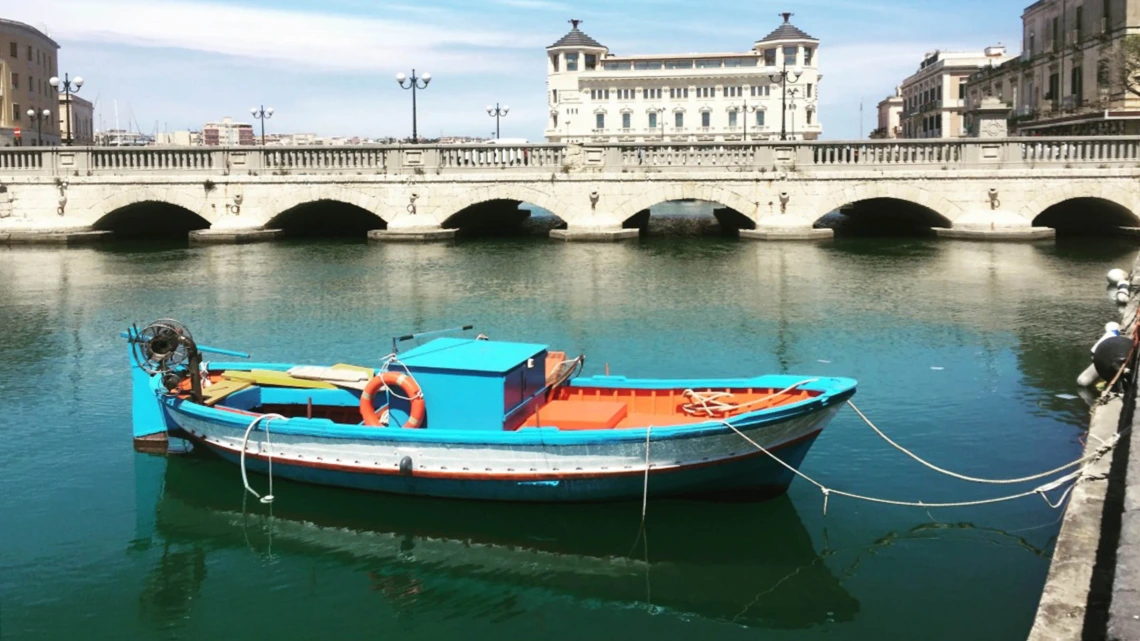
The idyllic setting of Sicily is the backdrop for career-broadening scientific and translational science discussions for the Health Sciences researchers who participate in the Eureka Institute program. (Photo courtesy Julie Ledford)
Call Carol Gregorio, PhD, the Pied Piper of “Eureka” moments. Not the ones scientists shout out in movies, but the ones that guide junior faculty members to greater achievements in translational science.
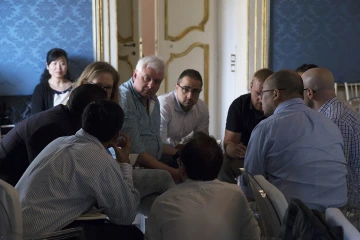
The days are long and collaborative. Scientists from around the world gather to share their expertise in not only the sciences, but also in getting funding and bringing life-saving drugs to market. (Photo courtesy Eureka Institute/Thirza Luijten)
In 2008, Dr. Gregorio decided to follow a former colleague’s dream of a worldwide gathering of translational scientists looking for ways to more effectively move discoveries from the lab to patients. In doing so, she bolstered the then-fledgling Eureka Institute.
A fateful flight
She credits Salvatore Albani, MD, PhD, former director of the UArizona Arthritis Center, for inspiring her with his vision.
“When we would go to department head and center director meetings, he would tell me about his vision of a global international certificate course that would address the challenges involved in getting from something you discover in the lab to the patient, and potentially backwards going from the patient to better scientific understanding in the lab,” Dr. Gregorio said. “To understand what happened to that patient at the molecular level in a rigorous scientific lab setting really takes a team. Dr. Albani just kept telling me how excited he was. And months later one day I said, ‘I'm coming to the course. I'm just coming.’ And I booked a flight.”
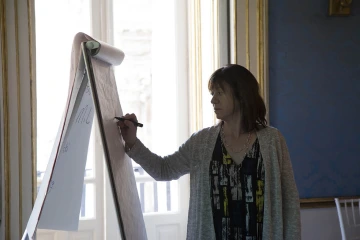
Carol Gregorio, PhD, is a veteran instructor and participant in the Eureka Institute program. (Photo courtesy Eureka Institute/Thirza Luijten)
The goal of the institute is simple, said Berent Prakken, MD, PhD, co-founder of Eureka and professor of immunology and pediatrics at the Utrecht Medical Center in the Netherlands. Help early-career researchers avoid the mistakes he made when trying to bring a drug from the basic lab to trials and ultimately to clinics.
“One day Dr. Albani and I were sitting together in Paris after another unsuccessful meeting with venture capital. So we had to start all over again. And it felt so close,” Dr. Prakken said. “And then we had this idea. We said, ‘Wouldn’t it be nice if other young people don't make the same mistakes that we make?’”
Drs. Prakken and Albani decided to form a network of people who could help them avoid the mistakes they had made and could see other scientists making as well. “We had a quite simple and naive idea. ‘Let's just bring together smart people and see if we can do something about this?’ And we got a small grant.”
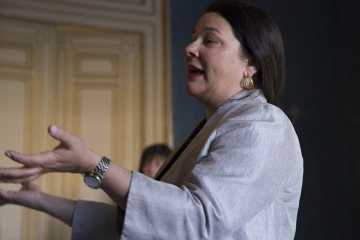
Nancy K. Sweitzer, MD, PhD, director of the Sarver Heart Center, speaks with Eurekans in 2018. (Photo courtesy Eureka Institute/Thirza Luijten)
“The interesting thing is, within moments of that first gathering, everybody agreed on the problem,” Dr. Prakken said. “That was one of the most amazing days I have had in my professional life, because we thought it would be two full days just to talk about the problem.”
From that moment on, a think tank of sorts for translational scientists was born. But the institute is more than a way to get papers published.
‘Nobody is cured by a paper’
The institute helps researchers become leaders. “That's what we incorporate in the class,” Dr. Gregorio said. “We talk every morning about what participants learned about communicating, about teaching. What did they learn about collaboration that they could bring back to their institution?”
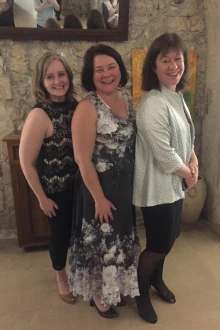
Julie Ledford, PhD; Nancy Sweitzer, MD, PhD; and Carol Gregorio, PhD, pose together before one of the group dinners in Italy. All three say the program is exhausting and exhilarating as they learn how to bring scientific discoveries to patients. (Photo courtesy Julie Ledford)
Health Sciences’ connection to the institute runs deep. According to Julie Ledford, PhD, associate professor in the Department of Cellular and Molecular Medicine, member of the UArizona Health Sciences Asthma and Airways Disease Research Center and a Eurekan herself, about 30 faculty members and 20 undergrad, graduate and MD/PhD students have now taken courses through the Eureka Institute. And that course work can be transformational.
“For me, it was a life changing experience,” she said. “At Eureka I was talking about my research to a patient advocate, and she convinced me to apply for a grant that I never would have considered. I came back and there were so many things that I was looking at, maybe not in the wrong way, but not the way I needed to be looking at differently to really move forward.”
That life-changing moment pushed Dr. Ledford into a whole new area of research and changed the trajectory of her career. “My research was on asthma,” she said. “All of my drug development, everything my lab did was about asthma. But I had been feeling for a while that chronic obstructive pulmonary lung disease, or COPD, was calling my name.”
“For me, it was a life changing experience. ”Julie Ledford, PhD
“I was talking to Pat Furlong (founder of Parent Project Muscular Dystrophy) at the Eureka course; she was a patient advocate. Her whole message is that the patient is most important. And she said, ‘If you really want to help, you just have to put yourself out there and write that grant.’ And I said, ‘I'll never get funded because I'm not an expert in COPD – I’ve never even published in the field.’ And she said ‘you know what, you're not going to get funded if you never write it. If you feel like this is the hole, the gap in knowledge that you can fill and you are the person that's supposed to do this, then do it.’”
That nudge changed Dr. Ledford’s career trajectory.
Transformative seminar
The fervor and uniformity with which Eurekans describe the transformational experience the institute provides is inspiring. For many junior faculty selected for the program, their current career path is like a stream with swift flowing water. Then a boulder rises in the middle of that stream. It doesn’t change the water, but it causes a slight shift in direction. That’s what Eureka does – it changes the direction of attendees’ thinking and alters career trajectories.

Group dinners are part of the “hidden” curriculum at the Eureka Institute. (Photo courtesy Julie Ledford)
One way the institute changes lives and careers is to get the attendees to work with people in the arts and other creative areas, which pushes attendees out of their scientific comfort zones and forces them to think about their science differently.
The institute also opens up a global network for attendees, providing access to people with different skill setsor who may have a better idea on how to start a company, how to get funding or how to market a product. Connections are made covering every aspect of moving discoveries toward treatments.
“You have people to help you get started in every aspect, and I think for early career researchers, especially, it's comforting to know we're not alone,” Dr. Ledford said. “There's a network of people across the world on our team now, trying to help us.”
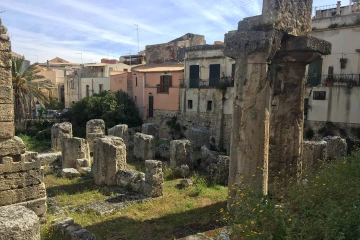
While the week at the institute means long and exhausting days, there also is time to see and experience the history of Italy. (Photo courtesy Julie Ledford)
The course is not easy and the days are long. But when you are in a place like Sicily, with its history, art and food, the “hidden curriculum” plays a critical role – when attendees aren’t in a session, when they get to socialize or take a quick break for that famous Italian gelato.
“It’s when we don't have a set agenda – during breakfast, during lunch, during dinner, after the day’s session is over – because we want attendees to recognize how much you can learn from people when you’re outside the classroom that can ultimately impact your work quite directly and profoundly,” Dr. Gregorio said. “Every year, when students and faculty come out of a week where we have worked so hard, we also realize we have made lifelong, worldwide connections. And that's what happens, like magic in a way, year after year.”
“It seems crazy, going to Italy for this experience, but once you get there, you immediately meet these people who are so very similar to you, and there’s no distraction,” Dr. Ledford said. “It gives you opportunity for momentous change. You begin to think differently about your 5- or 10-year-plan, and you start making changes to be sure you’re on track to accomplish your goals. The time there really helps you put that into place.”
Word is out
UArizona Health Sciences’ connection to the institute has had far reaching impact beyond the former attendees, particularly for recruiting and retention. “I don't think many universities can send junior faculty to Sicily for eight days, to meet leaders from across a variety of fields and build a global network,” Dr. Gregorio said. “But once attendees return to Tucson, it becomes infectious. We once brought a faculty candidate in, and when I met with her the first thing she asked was ‘Could you tell me about Eureka? The junior faculty all told me about it,’ and I thought, ‘Wait a minute!’”
“What we've seen from the junior faculty who attend Eureka is that they become far more successful and impactful in their careers,” said Nancy K. Sweitzer, MD, PhD, director of the Sarver Heart Center.
“After attendees complete Eureka, they collaborate more, they write more successful and collaborative grants, they broaden their horizons precisely in ways we hope they will, and in ways that engender career advancement. It's really been an unbelievably successful program for the university in transforming and building successful careers in translational science.”

